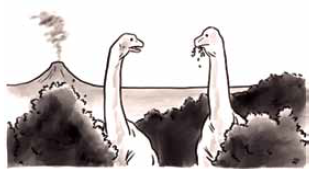Questões de Vestibular
Comentadas sobre interpretação de texto | reading comprehension em inglês
Foram encontradas 680 questões
Cerrado

Located between the Amazon, Atlantic Forests and Pantanal, the Cerrado is the largest savanna region in South America.
The Cerrado is one of the most threatened and overexploited regions in Brazil, second only to the Atlantic Forests in vegetation loss and deforestation. Unsustainable agricultural activities, particularly soy production and cattle ranching, as well as burning of vegetation for charcoal, continue to pose a major threat to the Cerrado’s biodiversity. Despite its environmental importance, it is one of the least protected regions in Brazil.
Facts & Figures
• Covering 2 million km2 , or 21% of the country’s territory, the Cerrado is the second largest vegetation type in Brazil.
• The area is equivalent to the size of England, France, Germany, Italy and Spain combined.
• More than 1,600 species of mammals, birds and reptiles have been identified in the Cerrado.
• Annual rainfall is around 800 to 1600 mm.
• The capital of Brazil, Brasilia, is located in the heart of the Cerrado. • Only 20% of the Cerrado’s original vegetation remains intact; less than 3% of the area is currently guarded by law.
(http://wwf.panda.org. Adaptado.)

Examine o cartum de Pia Guerra, publicado no Instagram da revista The New Yorker em 13.11.2018.

“I had that dream again where the small hairy creatures were selling my body for three dollars a gallon.”
A mercadoria a que o cartum faz alusão está diretamente relacionada ao seguinte problema ambiental:
Examine o cartum de Steinberg, publicado em seu Instagram em 06.04.2019.

Para o cartunista, a diferença entre estar ou não estar de
dieta limita-se a um sentimento de
Leia o texto para responder à questão.
Dying to defend the planet: why Latin America
is the deadliest place for environmentalists

February 11, 2017
Defending nature is a dangerous occupation, especially in Latin America. According to a recent report by Global Witness, an NGO, 185 environmental activists were murdered worldwide in 2015, an increase of 59% from the year before. More than half the killings were in Latin America. In Brazil 50 green campaigners died in 2015. Honduras is especially dangerous: 123 activists have died there since 2010, the highest number of any country relative to its population. Berta Cáceres, an indigenous leader who was a prominent campaigner against dams and plantations, was murdered there.
Why is Latin America so deadly? One reason is its abundant natural resources, which attract enterprises of all sorts, from multinationals to mafias. When prices are low, as they are now, the most rapacious do not go away; to maintain their profits they become more aggressive, says David Kaimowitz of the Ford Foundation, which gives money to good causes. New technologies open up new battlefronts. Soya beans bred to grow in tropical conditions have encouraged farmers to displace cattle ranchers, who in turn have advanced into the rainforest. Small prospectors can now extract gold from soil rather than just hunting around. That opens up new areas for exploitation, such as San Rafael de Flores in south-eastern Guatemala, where activists have been murdered.
The odds of finding the criminals are greater if the victim is foreign. Dorothy Stang, an American nun who fought to protect the Amazon rainforest, was killed in Brazil 12 years ago. Both the gunman and a rancher who had hired him eventually went to jail. But that is an exception.
(https://www.economist.com/the-americas/2017/02/11/
why-latin-america-is-the-deadliest-place-for-environmentalists. Adaptado)
Leia o texto para responder à questão.
Dying to defend the planet: why Latin America
is the deadliest place for environmentalists

February 11, 2017
Defending nature is a dangerous occupation, especially in Latin America. According to a recent report by Global Witness, an NGO, 185 environmental activists were murdered worldwide in 2015, an increase of 59% from the year before. More than half the killings were in Latin America. In Brazil 50 green campaigners died in 2015. Honduras is especially dangerous: 123 activists have died there since 2010, the highest number of any country relative to its population. Berta Cáceres, an indigenous leader who was a prominent campaigner against dams and plantations, was murdered there.
Why is Latin America so deadly? One reason is its abundant natural resources, which attract enterprises of all sorts, from multinationals to mafias. When prices are low, as they are now, the most rapacious do not go away; to maintain their profits they become more aggressive, says David Kaimowitz of the Ford Foundation, which gives money to good causes. New technologies open up new battlefronts. Soya beans bred to grow in tropical conditions have encouraged farmers to displace cattle ranchers, who in turn have advanced into the rainforest. Small prospectors can now extract gold from soil rather than just hunting around. That opens up new areas for exploitation, such as San Rafael de Flores in south-eastern Guatemala, where activists have been murdered.
The odds of finding the criminals are greater if the victim is foreign. Dorothy Stang, an American nun who fought to protect the Amazon rainforest, was killed in Brazil 12 years ago. Both the gunman and a rancher who had hired him eventually went to jail. But that is an exception.
(https://www.economist.com/the-americas/2017/02/11/
why-latin-america-is-the-deadliest-place-for-environmentalists. Adaptado)
Leia o texto para responder à questão.
Dying to defend the planet: why Latin America
is the deadliest place for environmentalists

February 11, 2017
Defending nature is a dangerous occupation, especially in Latin America. According to a recent report by Global Witness, an NGO, 185 environmental activists were murdered worldwide in 2015, an increase of 59% from the year before. More than half the killings were in Latin America. In Brazil 50 green campaigners died in 2015. Honduras is especially dangerous: 123 activists have died there since 2010, the highest number of any country relative to its population. Berta Cáceres, an indigenous leader who was a prominent campaigner against dams and plantations, was murdered there.
Why is Latin America so deadly? One reason is its abundant natural resources, which attract enterprises of all sorts, from multinationals to mafias. When prices are low, as they are now, the most rapacious do not go away; to maintain their profits they become more aggressive, says David Kaimowitz of the Ford Foundation, which gives money to good causes. New technologies open up new battlefronts. Soya beans bred to grow in tropical conditions have encouraged farmers to displace cattle ranchers, who in turn have advanced into the rainforest. Small prospectors can now extract gold from soil rather than just hunting around. That opens up new areas for exploitation, such as San Rafael de Flores in south-eastern Guatemala, where activists have been murdered.
The odds of finding the criminals are greater if the victim is foreign. Dorothy Stang, an American nun who fought to protect the Amazon rainforest, was killed in Brazil 12 years ago. Both the gunman and a rancher who had hired him eventually went to jail. But that is an exception.
(https://www.economist.com/the-americas/2017/02/11/
why-latin-america-is-the-deadliest-place-for-environmentalists. Adaptado)
Leia o texto para responder à questão.
Dying to defend the planet: why Latin America
is the deadliest place for environmentalists

February 11, 2017
Defending nature is a dangerous occupation, especially in Latin America. According to a recent report by Global Witness, an NGO, 185 environmental activists were murdered worldwide in 2015, an increase of 59% from the year before. More than half the killings were in Latin America. In Brazil 50 green campaigners died in 2015. Honduras is especially dangerous: 123 activists have died there since 2010, the highest number of any country relative to its population. Berta Cáceres, an indigenous leader who was a prominent campaigner against dams and plantations, was murdered there.
Why is Latin America so deadly? One reason is its abundant natural resources, which attract enterprises of all sorts, from multinationals to mafias. When prices are low, as they are now, the most rapacious do not go away; to maintain their profits they become more aggressive, says David Kaimowitz of the Ford Foundation, which gives money to good causes. New technologies open up new battlefronts. Soya beans bred to grow in tropical conditions have encouraged farmers to displace cattle ranchers, who in turn have advanced into the rainforest. Small prospectors can now extract gold from soil rather than just hunting around. That opens up new areas for exploitation, such as San Rafael de Flores in south-eastern Guatemala, where activists have been murdered.
The odds of finding the criminals are greater if the victim is foreign. Dorothy Stang, an American nun who fought to protect the Amazon rainforest, was killed in Brazil 12 years ago. Both the gunman and a rancher who had hired him eventually went to jail. But that is an exception.
(https://www.economist.com/the-americas/2017/02/11/
why-latin-america-is-the-deadliest-place-for-environmentalists. Adaptado)
Leia o texto para responder à questão.
Dying to defend the planet: why Latin America
is the deadliest place for environmentalists

February 11, 2017
Defending nature is a dangerous occupation, especially in Latin America. According to a recent report by Global Witness, an NGO, 185 environmental activists were murdered worldwide in 2015, an increase of 59% from the year before. More than half the killings were in Latin America. In Brazil 50 green campaigners died in 2015. Honduras is especially dangerous: 123 activists have died there since 2010, the highest number of any country relative to its population. Berta Cáceres, an indigenous leader who was a prominent campaigner against dams and plantations, was murdered there.
Why is Latin America so deadly? One reason is its abundant natural resources, which attract enterprises of all sorts, from multinationals to mafias. When prices are low, as they are now, the most rapacious do not go away; to maintain their profits they become more aggressive, says David Kaimowitz of the Ford Foundation, which gives money to good causes. New technologies open up new battlefronts. Soya beans bred to grow in tropical conditions have encouraged farmers to displace cattle ranchers, who in turn have advanced into the rainforest. Small prospectors can now extract gold from soil rather than just hunting around. That opens up new areas for exploitation, such as San Rafael de Flores in south-eastern Guatemala, where activists have been murdered.
The odds of finding the criminals are greater if the victim is foreign. Dorothy Stang, an American nun who fought to protect the Amazon rainforest, was killed in Brazil 12 years ago. Both the gunman and a rancher who had hired him eventually went to jail. But that is an exception.
(https://www.economist.com/the-americas/2017/02/11/
why-latin-america-is-the-deadliest-place-for-environmentalists. Adaptado)
Leia o texto para responder à questão.
Dying to defend the planet: why Latin America
is the deadliest place for environmentalists

February 11, 2017
Defending nature is a dangerous occupation, especially in Latin America. According to a recent report by Global Witness, an NGO, 185 environmental activists were murdered worldwide in 2015, an increase of 59% from the year before. More than half the killings were in Latin America. In Brazil 50 green campaigners died in 2015. Honduras is especially dangerous: 123 activists have died there since 2010, the highest number of any country relative to its population. Berta Cáceres, an indigenous leader who was a prominent campaigner against dams and plantations, was murdered there.
Why is Latin America so deadly? One reason is its abundant natural resources, which attract enterprises of all sorts, from multinationals to mafias. When prices are low, as they are now, the most rapacious do not go away; to maintain their profits they become more aggressive, says David Kaimowitz of the Ford Foundation, which gives money to good causes. New technologies open up new battlefronts. Soya beans bred to grow in tropical conditions have encouraged farmers to displace cattle ranchers, who in turn have advanced into the rainforest. Small prospectors can now extract gold from soil rather than just hunting around. That opens up new areas for exploitation, such as San Rafael de Flores in south-eastern Guatemala, where activists have been murdered.
The odds of finding the criminals are greater if the victim is foreign. Dorothy Stang, an American nun who fought to protect the Amazon rainforest, was killed in Brazil 12 years ago. Both the gunman and a rancher who had hired him eventually went to jail. But that is an exception.
(https://www.economist.com/the-americas/2017/02/11/
why-latin-america-is-the-deadliest-place-for-environmentalists. Adaptado)

No diálogo da tirinha,
De acordo com a charge a seguir, pode-se afirmar
que:

Leia o TEXTO 02 para responder à questão:

(Disponível em:.m:<http://www.incredibleteam.com/incredible-marketing-news/social-media-does-advertising-pay/> Acesso em: 10/09/2018)

Charges são produzidas com o intuito de satirizar comportamentos humanos e assim oportunizarem a reflexão sobre nossos próprios comportamentos e atitudes. Nessa charge, a linguagem utilizada pelas personagens em uma conversa em inglês evidencia:
I - a confusão mental do pai ao visitar o filho na cadeia e confundi-lo com outro presidiário.
II - o diálogo entre dois presidiários e um carcereiro
a respeito do sistema carcerário no Brasil.
III - a ausência de comunicação no sistema
carcerário.
IV - a distração do pai ao visitar o sobrinho preso na cadeia e confundi-lo com outro presidiário.
V - a ausência de comunicação entre pais e filhos.
Assinale a alternativa correta.
 Observe o anúncio e marque V
(verdadeiro) ou F (falso) nos itens a seguir. Logo
após, assinale a alternativa correta.
Observe o anúncio e marque V
(verdadeiro) ou F (falso) nos itens a seguir. Logo
após, assinale a alternativa correta. ( ) O anúncio faz a divulgação de vagas de estágio.
( ) O anúncio não exige conhecimento para o preenchimento das vagas.
( ) Para todas as vagas é exigida somente a formação em nível médio.
( ) As vagas de emprego são para uma estação de metrô.
( ) O anúncio informa que são mais de 34.400 lojas em todo o mundo.

Disponível em: <www.google.com.br/search?q=Marty+Bucella%27+cartoon&rlz> . Acesso em: 12 out. 2017.
The patient in this cartoon

Taken from <http://www.thatdeafguy.com/?p=697> . Accessed on August 21st, 2017
That Deaf Guy is a website that reproduces situations about a family in which the father is deaf. From this comic stripe one can infer that:
Leia a charge.

<https://tinyurl.com/y3lrke6a> Acesso em: 08.10.2019. Original colorido.
A ironia da charge se constrói no fato de
Leia a tirinha a seguir.

Na tirinha, o humor é evidenciado por meio
Considere a charge.

A charge, referente ao ambiente de trabalho, mostra um chefe sugerindo que seu funcionário

<https://tinyurl.com/y6fbtptu> Acesso em: 15.03.2019. Original colorido
Nos quadrinhos, pode-se observar que Alice se sente um tanto quanto decepcionada com a formação do novo líder
porque ele
